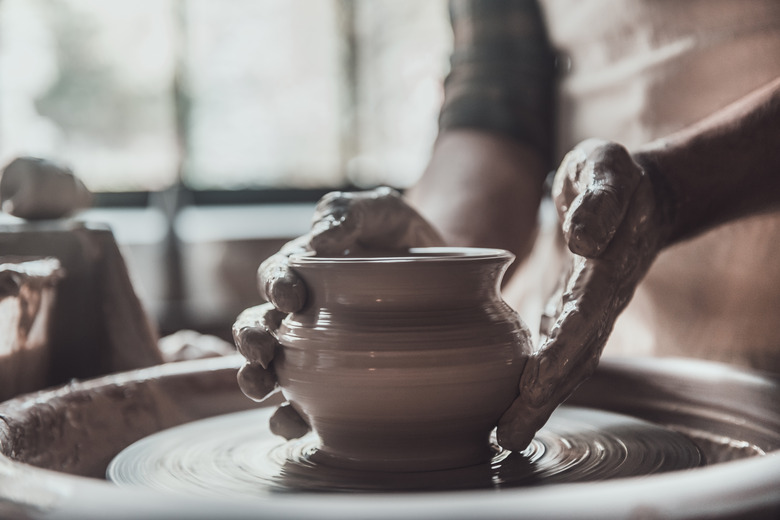Tools Made By People In Ancient Mesopotamia
The people of Mesopotamia — the Assyrians, Babylonians and Sumerians — created and used important and enduring tools. Clay, metal and other resources provided raw material for cutlery, cookware, dishes, weapons, farming equipment and artwork. Although few ancient tools from that area survived the wet soil and climate fully intact, archaeologists have learned a great deal from the writings on clay tablets, carved artwork on buildings and those objects that have been found. These artifacts show that Mesopotamians used tools much as we do today.
TL;DR (Too Long; Didn't Read)
Ancient Mesopotamians created many tools including cutlery, cookware, plows, bowls, the potter's wheel, drills, bows, arrows and spears.
Cooking Utensils and Home Construction
Cooking Utensils and Home Construction
Mesopotamians cooked with copper and clay, and recorded recipes on clay cuneiform tablets. They fast-boiled some foods in clay pots and simmered others in bronze cauldrons. Many Mesopotamians lived in mud brick houses that were caulked with tar. Single-pronged forks were made of bone; knives had blades of bronze or iron and metal, the material used to manufacture spoons included wood, Terra-cotta, bitumen, metal and sometimes ivory.
Plowing and Planting
Plowing and Planting
Early Mesopotamians began changing from hunter-gatherers to farmers who cultivated cereal crops around 6,000 B.C. Planting seeds requires scratching or plowing a furrow in the soil to receive the seeds. Their first plow was a simple stone blade attached to a wooden shaft and pulled by oxen. Around 2300 B.C., they revolutionized agriculture by accelerating planting processes with the seed plow. This implement attached a funnel to the plow to hold seed and deposit it in the furrow as the soil was plowed.
Pottery and the Potter’s Wheel
Pottery and the Potter's Wheel
Air-dried clay objects date back before 8000 B.C., but around 6000 B.C. Mesopotamians began using earthen or stone ovens to control the firing process, allowing for the development of true pottery. The earliest forms of pottery were probably slab- or coil-built: using clay slices or clay formed into thin ropes to build pots and bowls. These were decorated with designs pressed into or cut out of the clay with sticks or the potters' hand. Around 3500 B.C., Mesopotamians developed the potter's wheel, which made lighter weight, better balanced pottery. The potter's wheel is comprised of a platform that holds wet clay and rotates, allowing the potter to form and shape the clay into symmetrical wares. Potters keep their wheels turning at an even rate with their feet, assisted by a heavy flywheel. The design is still used by potters in the 21st century.
Lasting Arts and Craftsmanship
Lasting Arts and Craftsmanship
Mespotamians are known for their artistry and craftsmanship, in particular their beads, amulets, figurines and cylinder seals. They used drills to shape, pierce and decorate these objects. Chipped flint drills were used on soft stone such as marble, while copper drills were used on harder surfaces such as hematite.
Weaponry for War and Hunting
Weaponry for War and Hunting
Archery tackle — bows and arrows — was vital for combat and for hunting. In the time of King Sargon I, about 2350 B.C., the people of Mesopotamia began using the composite bow constructed by gluing together layers of wood from different trees with different elasticity and strength properties, using glues derived from animal bone and sinew. This bow design was so powerful and resilient that it persisted for centuries. Tips for arrows were originally chipped from stones and attached to the shaft with rope made of animal sinew or plant filaments. Later, stone tips were replaced by bronze or iron. Spears were also tipped with bronze or iron spearheads.
References
- The British Museum: Mesopotamia – Geography and Environment
- Everyday Life in Ancient Mesopotamia; Jean Bottero, et al.
- The British Museum: Mesopotamia — Technology
- University of Chicago: Ancient Mesopotamia – Science and Invention
- University of Chicago: It Happened First in Ancient Mesopotamia
- Ceramic Arts Daily: Wheel Throwing Techniques
- Daily Life in Ancient Mesopotamia By Karen Rhea Nemet-Nejat
- The Change from Stone Drills to Copper Drills in Mesopotamia
Cite This Article
MLA
Shneiderman, Dee. "Tools Made By People In Ancient Mesopotamia" sciencing.com, https://www.sciencing.com/tools-made-people-ancient-mesopotamia-9032/. 19 April 2018.
APA
Shneiderman, Dee. (2018, April 19). Tools Made By People In Ancient Mesopotamia. sciencing.com. Retrieved from https://www.sciencing.com/tools-made-people-ancient-mesopotamia-9032/
Chicago
Shneiderman, Dee. Tools Made By People In Ancient Mesopotamia last modified March 24, 2022. https://www.sciencing.com/tools-made-people-ancient-mesopotamia-9032/
